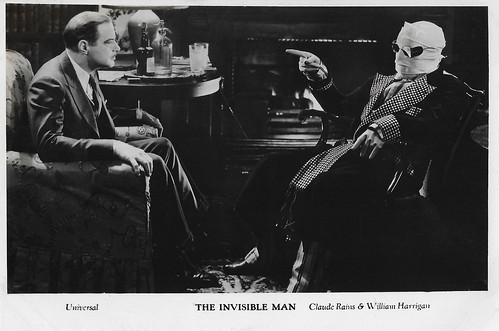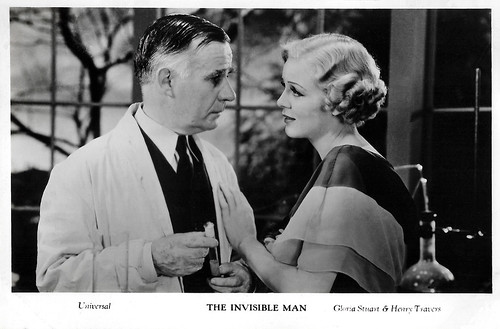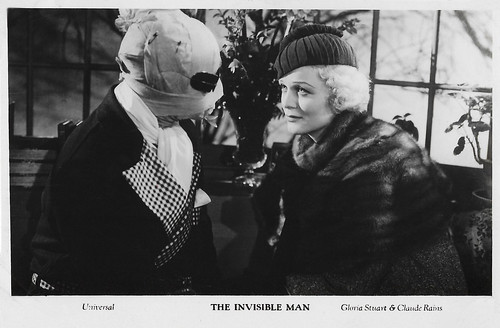The Invisible Man (James Whale, 1933) is one of the best films of the early Universal horror series of the 1930s. The script, based on H.G. Wells science fiction classic, is solid and tight, and James Whale's direction is creative and technically excellent. Debutant Claude Rains plays the scientist who has developed a serum which turned himself invisible, and into a raving, mad megalomaniac. Whale laces his special humour throughout the film, and The Invisible Man is full of dark comedic moments.

British postcard in the Filmshots series by Film Weekly. Photo: Universal. Publicity still for The Invisible Man (James Whale, 1933) with William Harrigan and Claude Rains.
A snow storm is blowing ferociously, a man trundles towards a signpost that reads Iping. When he enters a hostel called The Lions Head, the patrons of the bar fall silent for the man is bound in bandages.
He tells, not asks, the landlady; "I want a room with a fire". This man is Dr. Jack Griffin (Claude Rains), soon to be known as The Invisible Man. Director James Whale starts his classic horror fantasy The Invisible Man (1933) in a gripping style.
Working in Dr. Cranley's (Henry Travers) laboratory, Griffin was always given the latitude to conduct some of his own experiments. His sudden departure has Cranley's daughter Flora (Gloria Stuart) worried about him.
In his room in The Lions Head, Griffin hopes to reverse the experiment that made him invisible. Unfortunately, the drug he used has negative side effects, making him aggressive and dangerous.
Griffin is prepared to do whatever it takes to restore his appearance, and several people will die in the process. Finally the scientist has turned into a raving, mad megalomaniac bent on conquering mankind and the world.

British postcard in the Filmshots series by Film Weekly. Photo: Universal. Publicity still for The Invisible Man (James Whale, 1933) with Henry Travers and Gloria Stuart.

British postcard in the Filmshots series by Film Weekly. Photo: Universal. Publicity still for The Invisible Man (James Whale, 1933) with Claude Rains and Gloria Stuart.
The Invisible Man (James Whale, 1933) is filled with witty dialogue, excellent character acting, and a dazzling array of special effects. We get to see a shirt move on it's own, things fly around rooms and the invisible man causing mayhem.
What is most surprising about the film is its rather perverse sense of black humour (typical for Whale's films) and its cruelty. When a woman runs screaming down the lane at night followed by an empty pair of pants skipping along reciting "here we go gathering nuts in May", it is a funny tongue-in-cheek moment.
More darkly is the scene during a massive search for Griffin, after he causes a train disaster. One of the volunteers, slightly apart from the others, is grabbed and thrown down and choked. Griffin says, "Here I am...AREN'T YOU GLAD YOU FOUND ME?!!" It is a chilling moment.
The Invisible Man is not a benign horror monster but rather a frightening, destructive force capable of acts of violence, madness, and viciousness. Inventively, Whale combines script, acting, mood, and setting amidst the background of ground-breaking special effects that are still impressive to this day.
For Claude Rains, it was his first major film role. He spends much of the film either under the cover of bandages or not even in it. At the end of the film, he finally appears for a minute - as a corpse! But it doesn't matter because it's his voice that makes the performance and the role was for Rains his big break. The fiendishness of his voice is compelling and pure evil.
Baron Bl00d at IMDb: "The acting all around is very good with people like Henry Travers, Gloria Stuart, Una O'Connor and William Harrigan especially as a jealous doctor giving all the support they can to a formless Claude Rains. Rains's voice is magnificent and one senses he was made to play the part that would make him famous. Look also for Dwight Frye in a small role. A wonderful film experience!"

British postcard in the Filmshots series by Film Weekly. Photo: Universal. Publicity still for The Invisible Man (James Whale, 1933) with Gloria Stuart (and Claude Rains).
The scene with the invisible man terrorising the village. Source: Movieclips (YouTube)
Sources: Baron Bl00d (IMDb), Wikipedia and IMDb.

British postcard in the Filmshots series by Film Weekly. Photo: Universal. Publicity still for The Invisible Man (James Whale, 1933) with William Harrigan and Claude Rains.
A megalomaniac bent on conquering mankind and the world
A snow storm is blowing ferociously, a man trundles towards a signpost that reads Iping. When he enters a hostel called The Lions Head, the patrons of the bar fall silent for the man is bound in bandages.
He tells, not asks, the landlady; "I want a room with a fire". This man is Dr. Jack Griffin (Claude Rains), soon to be known as The Invisible Man. Director James Whale starts his classic horror fantasy The Invisible Man (1933) in a gripping style.
Working in Dr. Cranley's (Henry Travers) laboratory, Griffin was always given the latitude to conduct some of his own experiments. His sudden departure has Cranley's daughter Flora (Gloria Stuart) worried about him.
In his room in The Lions Head, Griffin hopes to reverse the experiment that made him invisible. Unfortunately, the drug he used has negative side effects, making him aggressive and dangerous.
Griffin is prepared to do whatever it takes to restore his appearance, and several people will die in the process. Finally the scientist has turned into a raving, mad megalomaniac bent on conquering mankind and the world.

British postcard in the Filmshots series by Film Weekly. Photo: Universal. Publicity still for The Invisible Man (James Whale, 1933) with Henry Travers and Gloria Stuart.

British postcard in the Filmshots series by Film Weekly. Photo: Universal. Publicity still for The Invisible Man (James Whale, 1933) with Claude Rains and Gloria Stuart.
Here I am...AREN'T YOU GLAD YOU FOUND ME?!!
The Invisible Man (James Whale, 1933) is filled with witty dialogue, excellent character acting, and a dazzling array of special effects. We get to see a shirt move on it's own, things fly around rooms and the invisible man causing mayhem.
What is most surprising about the film is its rather perverse sense of black humour (typical for Whale's films) and its cruelty. When a woman runs screaming down the lane at night followed by an empty pair of pants skipping along reciting "here we go gathering nuts in May", it is a funny tongue-in-cheek moment.
More darkly is the scene during a massive search for Griffin, after he causes a train disaster. One of the volunteers, slightly apart from the others, is grabbed and thrown down and choked. Griffin says, "Here I am...AREN'T YOU GLAD YOU FOUND ME?!!" It is a chilling moment.
The Invisible Man is not a benign horror monster but rather a frightening, destructive force capable of acts of violence, madness, and viciousness. Inventively, Whale combines script, acting, mood, and setting amidst the background of ground-breaking special effects that are still impressive to this day.
For Claude Rains, it was his first major film role. He spends much of the film either under the cover of bandages or not even in it. At the end of the film, he finally appears for a minute - as a corpse! But it doesn't matter because it's his voice that makes the performance and the role was for Rains his big break. The fiendishness of his voice is compelling and pure evil.
Baron Bl00d at IMDb: "The acting all around is very good with people like Henry Travers, Gloria Stuart, Una O'Connor and William Harrigan especially as a jealous doctor giving all the support they can to a formless Claude Rains. Rains's voice is magnificent and one senses he was made to play the part that would make him famous. Look also for Dwight Frye in a small role. A wonderful film experience!"

British postcard in the Filmshots series by Film Weekly. Photo: Universal. Publicity still for The Invisible Man (James Whale, 1933) with Gloria Stuart (and Claude Rains).
The scene with the invisible man terrorising the village. Source: Movieclips (YouTube)
Sources: Baron Bl00d (IMDb), Wikipedia and IMDb.
No comments:
Post a Comment